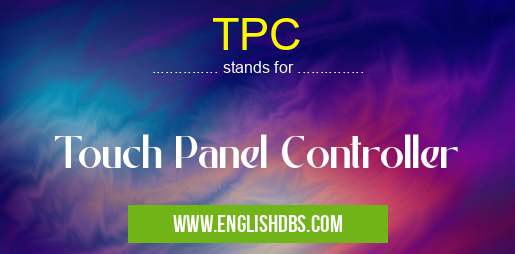What does TPC mean in UNCLASSIFIED
TPC stands for Touch Panel Controller. It is an electronic device that is used to control the operation of a touch panel display. Touch panels are commonly used in a wide range of electronic devices, such as smartphones, tablets, and laptops.

TPC meaning in Unclassified in Miscellaneous
TPC mostly used in an acronym Unclassified in Category Miscellaneous that means Touch Panel Controller
Shorthand: TPC,
Full Form: Touch Panel Controller
For more information of "Touch Panel Controller", see the section below.
Functions of a TPC
The primary function of a TPC is to receive input from the touch panel and then process that input to determine the user's intended action. The TPC then sends the appropriate commands to the device's operating system or application software to perform the desired action.
Types of TPCs
There are two main types of TPCs:
- Capacitive TPCs: These TPCs use capacitors to detect the presence of a user's finger on the touch panel.
- Resistive TPCs: These TPCs use a grid of resistors to detect the presence of a user's finger on the touch panel.
Benefits of TPCs
TPCs offer a number of benefits over traditional input devices, such as keyboards and mice. These benefits include:
- Ease of use: TPCs are very easy to use, even for users who are not familiar with technology.
- Durability: TPCs are very durable and can withstand a lot of wear and tear.
- Versatility: TPCs can be used in a wide range of applications, from smartphones to industrial control systems.
Essential Questions and Answers on Touch Panel Controller in "MISCELLANEOUS»UNFILED"
What is a Touch Panel Controller (TPC)?
A TPC is an electronic device that interprets signals from a touchscreen and converts them into commands for the connected computer or device. It acts as the intermediary between the user's touch input and the system's response.
What are the main functions of a TPC?
TPCs perform several key functions:
- Detect and decode touch events (e.g., touch, swipe, tap)
- Process touch data and determine the user's intentions
- Generate and send corresponding commands to the connected device
- Calibrate the touchscreen to ensure accurate touch response
What types of touchscreens are compatible with TPCs?
TPCs can work with various touchscreen technologies, including:
- Capacitive touchscreens
- Resistive touchscreens
- Infrared touchscreens
- Surface acoustic wave touchscreens
How does a TPC connect to a computer or device?
TPCs typically connect to a computer or device through an interface such as:
- USB
- Serial
- I2C
- SPI
What are the benefits of using a TPC?
Using a TPC offers several advantages:
- Enhanced user experience: TPCs enable intuitive and natural touch-based interactions.
- Increased efficiency: TPCs streamline workflows by providing direct control over applications and devices.
- Improved durability: Touchscreens are often more durable than traditional input devices, reducing equipment downtime.
Final Words: TPCs are an essential component of many modern electronic devices. They provide an easy and intuitive way for users to interact with these devices. As technology continues to evolve, TPCs are likely to become even more important in the years to come.
TPC also stands for: |
|
| All stands for TPC |
